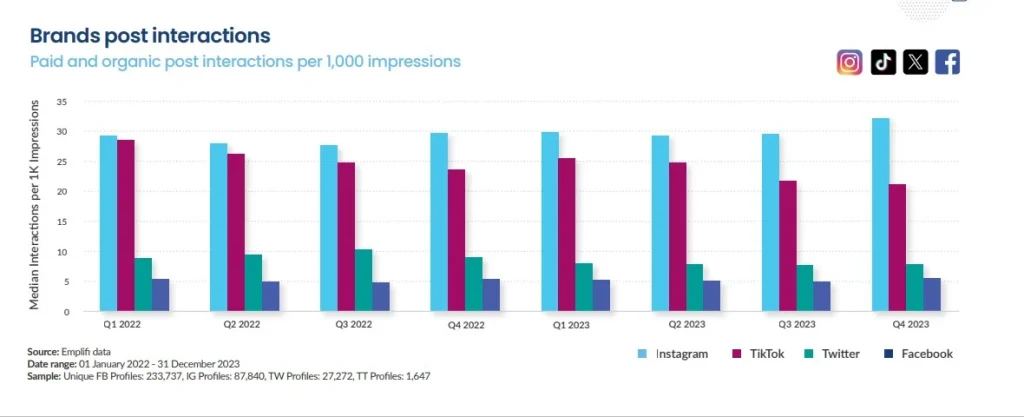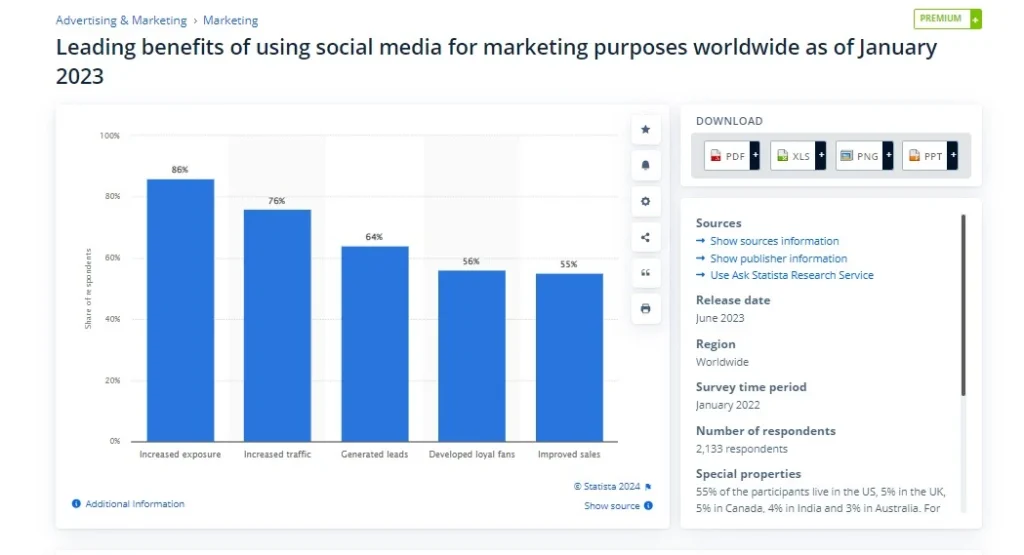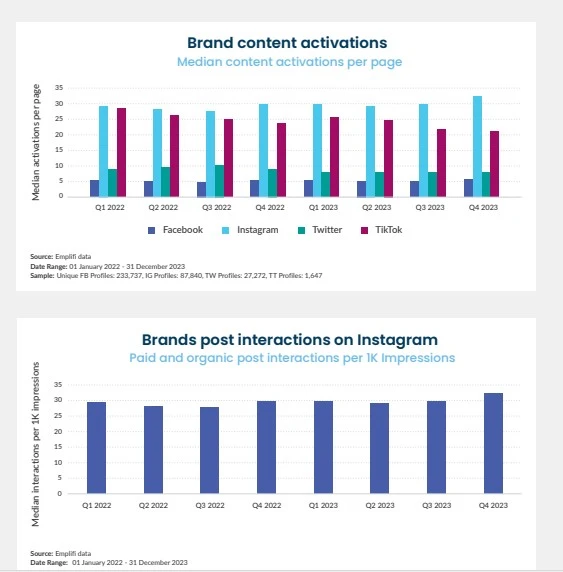From a local bakery with a few staff to handmade jewelry, social media are opening their arms to small businesses.
They offer diverse features, mostly free, and this is an incredible opportunity for local businesses to promote their products to a huge number of people who spend time online.
However, social media marketing for small business requires a strategy. Don’t panic. Easier than you imagine! Read on to learn how to create your own SMM strategy.
Does Social Media Marketing Work for Small Businesses?
Strongly Yes! Let’s figure out Why:
- As of January 2023, there are 5.04 billion social media users around the world. Meaning? A vast potential customer base for small businesses.
- Brands’ posts on social media create high interactions (As you see in Social Media Benchmarks, 2024 Report by Emplifi).

- 52% of online brand discovery comes from social media platforms.
- 66% of marketers generated new leads by social media.
- Small businesses achieve a 133% median return on investment (ROI) from social media advertising.
Benefits of Social Media Marketing (SMM) for Small Business
Social media are free and flexible platforms that help brands and businesses build brand awareness and connect with their target audience. Here are the most important benefits of SMM for a small business.

Source: Statista
- Cost-effective reach: Compared to traditional advertising, social media allows you to connect with a large audience for free (organically) or at a relatively low cost (through paid advertising).
- Targeted marketing: Social media platforms offer powerful targeting options. You can reach people based on demographics, interests, and online behavior, ensuring your message reaches the right customers.
- Brand Awareness & Engagement: Social media allows you to share your brand story, showcase your products or services, and interact with your audience. This builds brand recognition and loyalty.
- Increased Website Traffic & Sales: By sharing engaging content and website links, you can drive traffic to your website and convert visitors into customers.
- Customer Insights & Feedback: Social media is a goldmine for customer insights. You can learn about their preferences, answer questions, and address concerns in real-time, fostering positive relationships.
Which Social Media Are Best for Small Businesses?
Choosing the best social media platform for marketing depends on your business and target audience.
However, the following platforms are small businesses’ most powerful social media channels.
- Facebook is the largest social media platform with around 3.05 billion monthly active users worldwide.
- The United States has the second most Facebook users (188M) after India.
- Globally, 56.8% of Facebook users are male compared to a 43.2% female user base.
- As of January 2024, users aged 25 to 34 years made up Facebook’s largest audience in the United States, accounting for 24.4 percent of the social network’s user base.
In addition to a massive user base and free registration, Facebook offers extra benefits to businesses.
- Facebook’s advertising platform allows for highly targeted campaigns.
- . If you choose to run paid ads, Facebook offers a budget-friendly approach.
- There are lots of free tools and features for small businesses like posting content, using Reels to engage followers, sharing Stories for 24 hours, messaging directly with customers, joining relevant groups, hosting Live videos, adding action buttons on Pages, and creating online shops.
- You can also create and promote events on Facebook to generate interest and engagement around upcoming sales, product launches, or in-person events.
- Instagram has 2 billion monthly active users worldwide, as of January 2024.
- According to Social Media Benchmarks Report 2024 by Emplifi: “Instagram saw increases in content activations across 2023, and that’s likely because brands have been rewarded for investing their resources in the channel”.

- 130 million users tap on Instagram shopping posts monthly and 70% of Instagram shoppers use this platform for product discovery (Source: Gitnux.org).
- A 2020 study commissioned by Facebook suggests that 44% of surveyed people strongly associate Instagram with discovering local/small brands.
- There are over 200M business accounts on Instagram.
Let’s find out what draws this huge number to Instagram.
- You’ve got exclusive features like a business account, and a professional dashboard to track your performance.
- You can set up your own shop, run ads, boost an Instagram post, and partner with other brands.
- As a small business, you can also showcase your products, services, team, or work environment through high-quality photos and videos.
- Besides, you can engage directly with your followers by responding to comments and reactions and replying to direct messages.
YouTube
- YouTube is the second most popular social media, followed by Facebook with 2.49 billion monthly active users.
- According to the most recent studies in 2020, 70% of viewers purchased after seeing a brand on YouTube.
Let’s go beyond the numbers and take a look at YouTube’s features for small businesses:
- Search Engine Optimization (SEO) Benefits: Videos can rank well in search engine results pages (SERPs), increasing organic reach and attracting viewers actively searching for solutions or information related to your business.
- Versatility of Video Content: Showcase your products, services, expertise, or brand story through various video formats like tutorials, demonstrations, customer testimonials, behind-the-scenes glimpses, or even entertaining skits.
- Building Brand Trust and Authority: High-quality, informative videos establish you as a thought leader in your industry and build trust with potential customers.
- Engagement Features: Comments, likes, dislikes, and polls on YouTube videos allow for audience interaction and foster a sense of community around your brand.
TikTok
- TikTok boasts around 1.562 billion monthly users worldwide.
- Studies suggest that in October 2023, brands could reach 1.218 billion users aged 18 and above on TikTok.
Just like Meta, TikTok offers various marketing tools and resources:
- You can set up a business account and have access to content analytics.
- TikTok Creators Marketplace and TikTok Ads Manager allow you to find the right creators and run paid ads.
- This platform also offers advanced targeting tools to create a custom audience.
X (Former Twitter)
- There are up to 619 million monthly active users on X (Twitter) worldwide- as of January 2024.
- 67% of B2B marketers use Twitter as a digital marketing tool.
- 54% of Twitter’s audience is more likely to purchase new products (SocialPilot).
Is Twitter good for small businesses?

- You can set up a professional account and access additional tools and features like a dashboard to track your performance and discover product offerings
- You can also present your business info like location, opening hours, and contact info on your profile.
- Twitter allows you to promote your post-just like Meta.
- You can run ads in different formats on Twitter.
- By January 2024, there are 482 million monthly users on Pinterest worldwide.
- 46% of weekly pinners discovered a new brand or product on Pinterest.
- Marketers could reach 282.5 million users on Pinterest in early April 2023 (KEPIOS).
Here are the features Pinterest offers to brands and businesses:
- Pinterest Ads
- Audience Insights
- Pinterest Academy (E-learning)
- Shopping solutions including catalogs
Snapchat
- Snapchat has 750 million monthly users around the world.
- According to reports, Snapchat reaches 90% of the 13-24-year-old population and 75% of the 13-34-year-old population in 25+ countries.
- Advertisers could reach 654.4 million users on Snapchat in April 2023 (Datareportal).
What features Snapchat provides for small businesses?
- Advertising on Snapchat reaches a large and engaged audience, particularly Millennials and Gen Z.
- This platform also offers social shopping features, audience targeting capabilities, ad creation tools, and measurement options to optimize ad campaigns.
Social Media Marketing for Small Business: How to Choose the Right Platform
Needless to say, the above platforms are the best for SMM. But that doesn’t mean you should include all of them in your social media marketing strategy.
Pick one or two that match your business goals most. Below, you can find factors to consider when choosing a social medium.
Your target audience
First, define who you’re trying to reach. Age, location, gender, and income can all influence platform choice.
For example, platforms like Snapchat and TikTok skew younger, while Facebook and LinkedIn cater to a broader age range.
Interests: Is your audience interested in visuals (Instagram, Pinterest) or quick updates (Twitter)?
Online behavior: Research where your ideal customers hang out online.
Business and content type
Identify what type of content can present your brand and business best. Photos, short videos, or maybe texts?
Time & resources
Be realistic about your capacity and budget. Each platform requires different content formats, posting frequency, expertise, and ad budget. So, focus on the platform (s) you can afford.
How to Promote Your Business on Social Media
To best promote your small business on social platforms, you first need a Social Media Marketing Strategy.
Social media marketing strategy is simply your roadmap to success on social media platforms that outlines your goals, target audience, the tactics you’ll use, and how you’ll measure your progress.
Here’s a general step-by-step guide on how to create your SMM strategy. It’s worth noting that each platform can have its own strategy.
#1. Define your goals & KPIs
Set a SMART goal (s)- Specific, Measurable, Attainable, Relevant, and Time-bound. The most common social media objectives include:
- Increasing brand awareness
- Driving more traffic to your website
- Building brand loyalty
- Driving more sales
- Generating new leads
- Building a community around your business
- Building relationships with customers
Note that for each goal, you should also define related KPIs such as:
likes, comments, saves, shares, mentions, new followers, reaches, conversions, hashtags, click-throughs, impressions, and brand mentions.
#2. Identify your target market
Specify who you’re trying to connect with. You need info including demographics, interests, online behavior, and pain points to create a buyer persona.
Remember; to create a precise and clear buyer persona, you better conduct market research through surveys, interviews, and social media analytics tools.
#3. Observe you and your competitors
Now, it’s time to evaluate your social media presence by answering these questions:
- Which platforms are you on?
- Which one performs best?
- What hashtags are you using?
- What types of content do you create?
- How many followers do you have?
- How engaged are your followers?
- What are your strengths and weaknesses?
Then, find your top competitors and ask the same questions about them to spot the differences.
#4. Create a content strategy
Depending on the social media you choose, you’ll need a content strategy to plan, develop, and manage your content.
You should also create a content calendar to specify the date, time, and type of content.
Bonus tips:
- Be consistent and create original content to build a strong social media presence.
- Use different organic content types such as images, videos, GIFs, Live streaming, Texts, Stickers, and more to tell your story.
- Leverage diverse content ideas like behind-the-scenes, product tutorials, new product launches, Live Q&A, or user-generated to present your business.
- Post your content at the right time to get the maximum reach. Also, opt for scheduling your social media content.
#5. Connect with creators
Collaboration with partners and other brands is a proven method to grow your business on social media and build trust. To make the most of this method:
- Find creators your target audience already follows.
- Engage with them on social media and reach out directly.
- Partner on campaigns like giveaways or reviews.
- Consider affiliate marketing programs for ongoing promotion.
#6. Run paid ads
All social media platforms have Ad Manager that allows you to run paid ads and campaigns in different formats with the targeted audience and then measure your ads performance.
This is particularly useful for small businesses as they can spend the right amount of budget to reach the right audience.
#7. Track, analyze, and adjust
Remember your goals and KPIs? Now, it’s time to measure them and see what works and what doesn’t.
Hopefully, each platform offers an Insight section where you can gain detailed insights into your content.
Just remember: Measure the right metrics depending on your goals and assess your strategy regularly to keep updated with trends and changes.
Social media marketing tools for small businesses
It’s 2024 and social media management tools have become like beloved members of business families. But hey, here’s the scoop:
Are social media outsourcing companies affordable for small businesses?
Well, yes, some of them offer affordable packages that save you time by streamlining content creation, scheduling, and analytics, allowing you to focus on other aspects of your business.
One great example is AiGrow-an organic Instagram growth tool with diverse features for content creation, scheduling posts, finding potential followers through hashtags, advanced account analytics, and more to grow your account.
AiGrow is totally manual and an account manager performs the best marketing strategies to help you boost.
FAQs
What is the best social media for small businesses?
The best social media platform for a small business depends on goals and target audience. However, Facebook, Instagram, YouTube, Twitter, TikTok, Pinterest, and Snapchat are the best marketing platforms.
How can I start social media marketing for my business?
You can start by creating a social media marketing strategy and defining your goals and related KPIs, your target audience, suitable platforms, setting up a business account, creating a content strategy, running ads, and tracking your strategy.